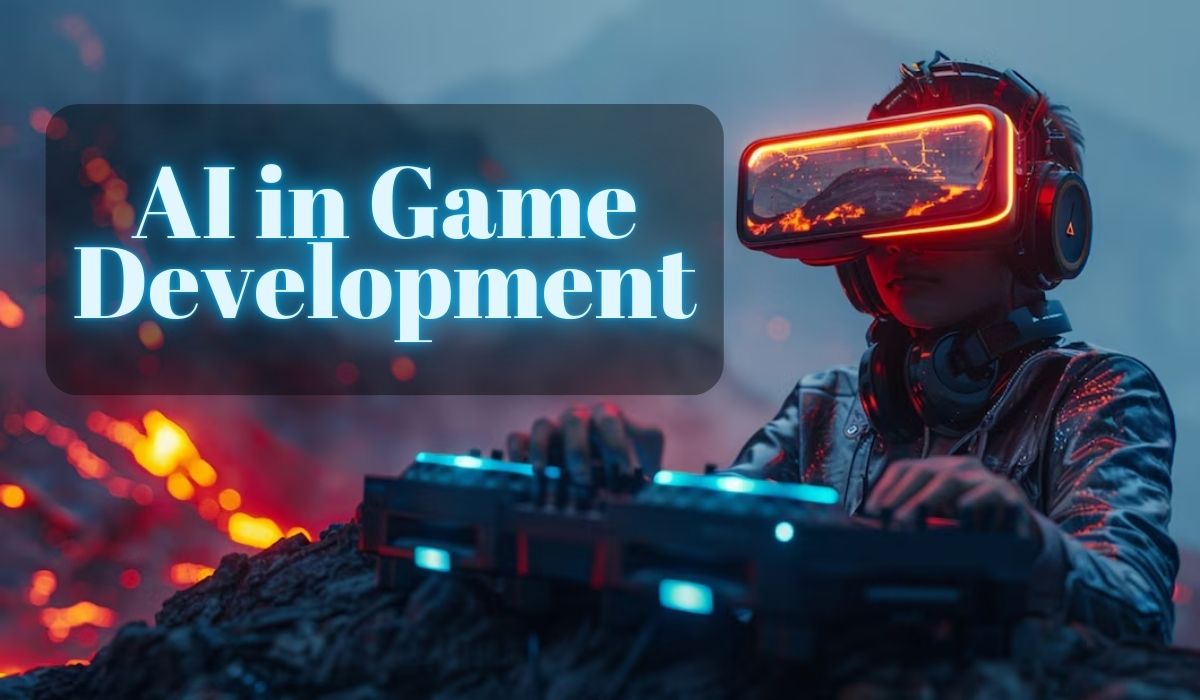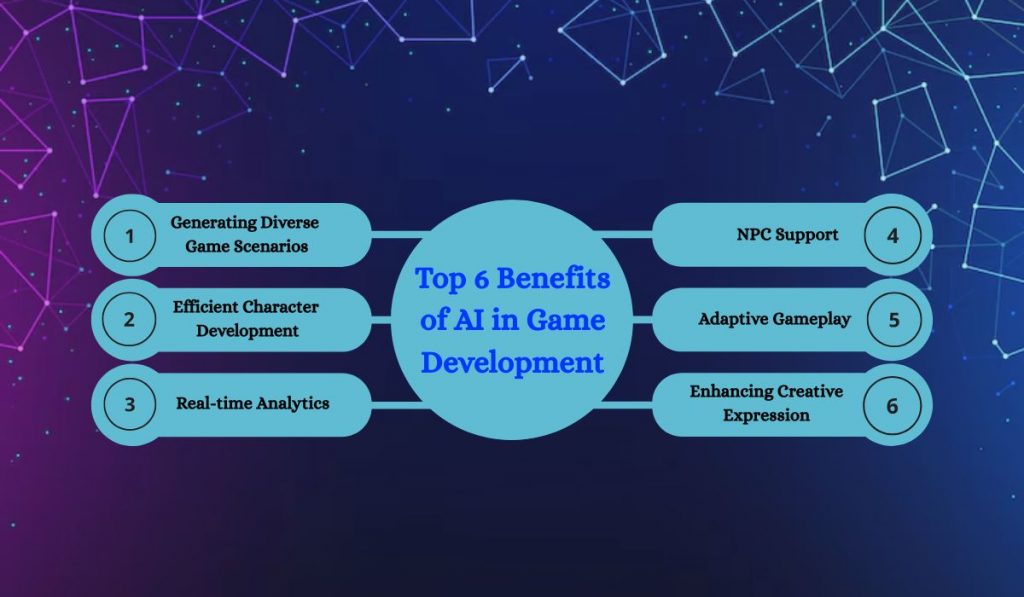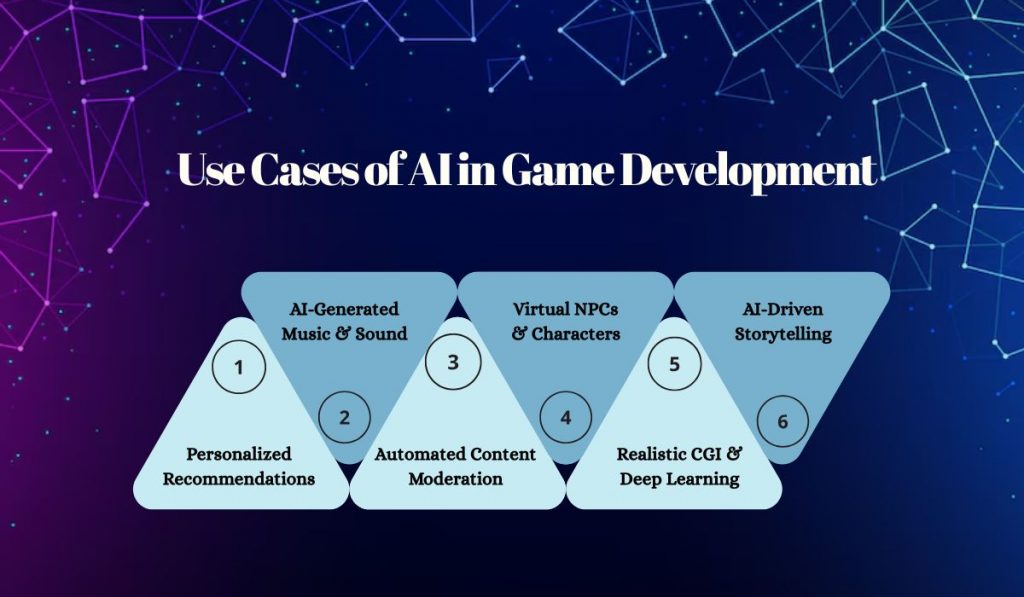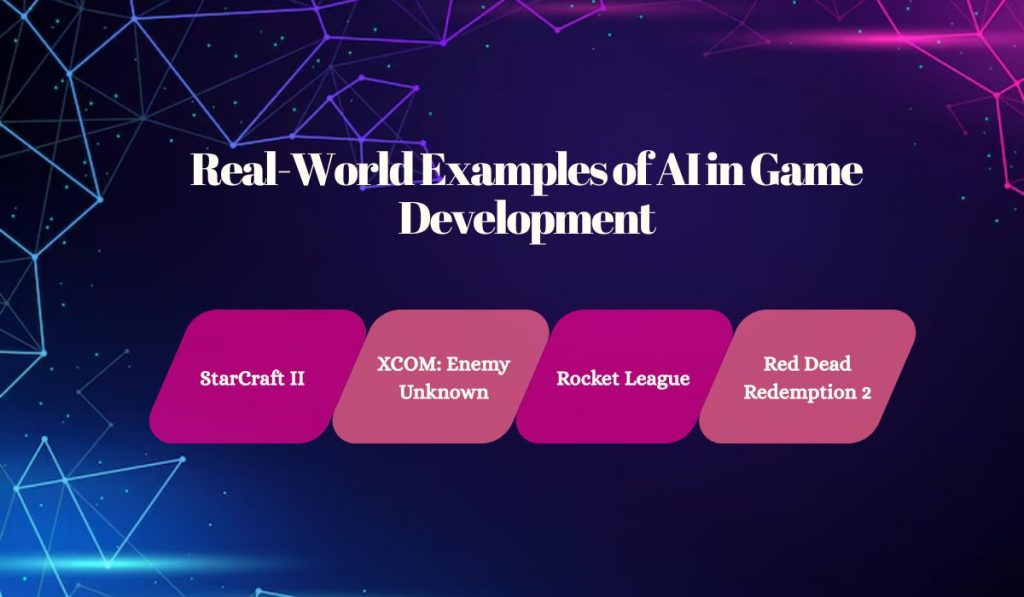
How AI in Game Development is Changing the Gaming World

The world of gaming is evolving rapidly, with every new console, graphics engine, or storyline promising a more immersive experience. But behind many of today’s groundbreaking advancements in the gaming industry lies a powerful driving force — Artificial Intelligence (AI). From developing smarter non-player characters (NPCs) to crafting entire virtual worlds that respond to player decisions in real time, AI in game development is reshaping how games are designed, played, and experienced.
Modern gamers expect more than just visuals and mechanics; they seek interactivity, personalization, and realism. That’s where AI in the gaming industry steps in. By integrating intelligent systems, developers can now create dynamic environments, lifelike characters, and personalized experiences that adapt to each player’s style.
Whether it’s generating adaptive narratives or building intelligent enemies that learn from players’ strategies, the role of AI is becoming increasingly central to the gaming experience. In this blog, we’ll dive deep into how AI works in games, explore its benefits, real-world applications, future potential, and the challenges that come with its implementation.
What is AI in the Gaming Industry?
AI in the gaming industry refers to the use of artificial intelligence technologies and algorithms to create responsive, adaptive, and intelligent behavior in games. It’s not just about making enemies harder to beat or NPCs more lifelike — it’s about transforming every layer of game design to make digital worlds more realistic, engaging, and immersive.
At its core, AI in game development involves programming systems to make decisions based on data. This could be as simple as a character patrolling an area or as complex as an entire ecosystem reacting to the player’s choices. Game AI can learn from player behavior, adjust difficulty levels dynamically, and even generate unique experiences for every playthrough.
The use of AI isn’t limited to gameplay mechanics. It extends to game testing, procedural content generation, automated story development, realistic animation, and even voice and sound design. Developers are increasingly integrating AI tools like machine learning and deep learning models into game engines to create more dynamic game worlds and lifelike characters.
With AI, game environments can now evolve in real time. Characters can exhibit emotions, make decisions based on previous interactions, and respond to unpredictable scenarios — just like a real player might. This advancement is pushing the boundaries of traditional game logic and enabling the creation of open-ended narratives and sandbox environments that feel truly alive.
In essence, AI in game development is not just a tool but a creative partner. It enables developers to focus more on storytelling and artistic direction while delegating repetitive and complex tasks to intelligent systems. As technology matures, its role in the gaming industry will only grow, unlocking more possibilities for developers and unforgettable experiences for players.
How Does AI Work in Games?
AI in games works by simulating decision-making and behavior patterns, giving characters, environments, and systems the ability to “think” and respond autonomously. Unlike traditional scripting where events are pre-programmed, AI enables games to react and adapt dynamically based on player interactions. Let’s break down the core components that make AI in games function effectively:
Pathfinding and Navigation
One of the most common uses of AI in games is pathfinding, which allows characters (such as NPCs or enemies) to navigate complex environments. This is done through algorithms like *A (A-star)**, which helps characters find the most efficient route to a target while avoiding obstacles. Pathfinding is essential in games where characters need to move through open-world environments or participate in strategic combat.
Decision Trees and Behavior Trees
AI systems often use decision trees or behavior trees to determine how characters behave in certain situations. These structures represent various possible actions and outcomes, enabling NPCs to make choices based on their current state and the environment. For example, in a strategy game, an enemy might choose to attack or retreat depending on the player’s positioning and the current health of their own character.
Machine Learning (ML) for Adaptive AI
Some modern games are using machine learning to create adaptive AI, which learns from the player’s behavior. For instance, the AI might adjust the difficulty level based on how well the player is performing. It can also predict player strategies and adjust NPC behavior to challenge the player more effectively. This creates a more engaging and unpredictable experience that evolves with the player’s style.
Finite State Machines (FSM)
A Finite State Machine is a model that can control the behavior of game characters by transitioning between different states (e.g., idle, patrol, attack). FSMs enable NPCs to react to stimuli, such as the player entering their line of sight or triggering a specific event. This system is commonly used in tactical or strategy games, where characters need to perform a range of actions depending on specific conditions.
Procedural Content Generation
AI is also widely used in procedural content generation, where game levels, environments, and even entire worlds are generated algorithmically rather than manually designed. This is particularly useful in open-world games where vast landscapes need to be created without exhausting developer resources. Procedural generation helps keep gameplay fresh by creating unpredictable content each time the player plays, making every experience unique.
Emotion Simulation and Dialogue Systems
In narrative-driven games, AI is used to simulate emotions and dialogue systems, allowing characters to respond to the player in emotionally appropriate ways. AI-driven dialogue trees are used to create realistic conversations that influence the story based on the player’s choices. Some advanced systems even analyze the tone of the player’s speech or actions to adapt responses in real-time, making interactions feel more natural.
Why Choose AI for Game Development?
AI brings smarter game mechanics, enhances storylines, and creates more engaging player experiences, making your games stand out.
Top 6 Benefits of AI in Game Development

The integration of AI in game development offers numerous advantages, not only for developers but also for players, enhancing both the creative and technical aspects of game design. Below are the top 6 benefits that AI brings to the world of gaming:
-
Generating Diverse Game Scenarios
AI allows for the generation of diverse game scenarios, creating environments and experiences that adapt based on player behavior. In traditional game development, scenarios and levels are pre-designed, limiting variety. With AI, however, games can generate dynamic scenarios, ensuring no two playthroughs are exactly the same. This is particularly useful in procedural content generation, where AI can create new, unique maps, levels, or challenges based on the player’s progress and actions.
For example, a role-playing game (RPG) might adjust the storyline or quest outcomes depending on decisions the player makes, creating a highly personalized experience. This level of adaptability keeps players engaged by offering fresh, unpredictable gameplay each time they interact with the game.
-
Efficient Character Development
Developing realistic characters with complex behavior patterns can be time-consuming and difficult. AI in game development streamlines this process by enabling efficient character development. NPCs can exhibit a wide range of behaviors that simulate real-life decision-making, emotions, and social interactions, allowing characters to seem more lifelike.
For instance, in open-world games, AI can control how NPCs react to the player and each other based on various factors such as personality, mood, or past interactions. This leads to more immersive and believable worlds, where characters can form dynamic relationships with players, react to their actions, or even evolve over time based on the story.
-
Real-time Analytics
One of the significant advantages of AI is its ability to perform real-time analytics within games. AI can monitor player behavior and adapt the game dynamically to optimize the experience. For example, if a player is struggling with a certain level, the AI might adjust the difficulty to provide assistance, such as offering additional health packs or slowing down enemies. Conversely, if a player excels at a particular aspect of the game, the AI can ramp up the challenge to keep the experience engaging.
In multiplayer games, real-time AI analytics can help developers track performance metrics, user engagement, and overall game balance. This data can be used to fine-tune gameplay, fix bugs, or improve in-game mechanics, creating a constantly evolving game environment.
-
NPC Support
AI-driven NPC (Non-Player Character) support is one of the most revolutionary aspects of modern gaming. Gone are the days of simple NPCs that follow rigid scripts. Today’s NPCs powered by AI can respond to the player’s actions in real-time, learning from the player’s choices, and adapting their behavior accordingly.
For example, in strategy games like XCOM: Enemy Unknown, enemies are not just following a set of instructions; they adapt to the player’s tactics and make decisions based on the current situation. This creates a more challenging and unpredictable gaming experience. AI also allows for more natural team interactions, where NPC allies can assist players in combat, react to changing conditions, or even offer strategic advice.
-
Adaptive Gameplay
One of the most impressive features of AI is its ability to create adaptive gameplay. Rather than sticking to a fixed set of rules or difficulty levels, AI systems can continuously analyze how a player approaches challenges and adjust the game mechanics accordingly. This creates an experience that feels more personalized and responsive to the player’s actions.
In games like Rocket League, for instance, the AI can adjust the difficulty of opponent teams based on the player’s skill level, ensuring that the game remains fun and challenging at all times. Adaptive AI can also tailor the pacing of a game, ensuring that players remain engaged without feeling overwhelmed or bored.
-
Enhancing Creative Expression
AI is not just a technical tool; it is also a means of enhancing creative expression in game development. By handling repetitive tasks such as animation, character behavior scripting, or environment design, AI allows developers to focus more on the artistic and creative aspects of the game. It can assist with procedural generation of landscapes, dynamic weather patterns, or even the creation of complex in-game narratives.
For example, in story-driven games, AI can help create branching storylines that evolve based on player decisions, creating more immersive and emotionally impactful experiences. Developers can experiment with more ambitious ideas, knowing that AI will help manage the technical complexity of their creations.
6 Use Cases of AI in Game Development

AI is being used in a variety of innovative ways to enhance gaming experiences. Here are 6 use cases of AI that showcase its potential in the gaming industry:
Personalized Recommendations
AI in game development can personalize game recommendations by analyzing player preferences and behavior. By studying factors like play style, preferred genres, and difficulty levels, AI can suggest games or content tailored specifically to individual players. This creates a more customized gaming experience, increasing engagement and retention.
AI-Generated Music & Sound
Partnering with a generative AI development company can assist in creating AI-generated music and sound effects, offering a dynamic and adaptive auditory experience. In games with procedurally generated content, the soundtrack can change depending on the player’s environment, actions, or storyline progression, creating a seamless and immersive atmosphere. AI can also be used to generate realistic ambient sounds, voiceovers, and even character dialogues, enhancing the overall experience.
Automated Content Moderation
In online multiplayer games, AI plays a critical role in automated content moderation. It can scan player-generated content such as chat messages, images, and user interactions for inappropriate or harmful material, ensuring a safer and more enjoyable environment. This reduces the need for human moderators and allows for real-time intervention, enhancing the overall online experience.
Virtual NPCs & Characters
AI-driven virtual NPCs and game characters offer more dynamic and lifelike interactions. Rather than following pre-set scripts, these characters adapt to the player’s actions and environment. For instance, in open-world games, AI can control the behavior of NPCs, making them react to player choices, form alliances, or even evolve over time based on their interactions with the player.
Realistic CGI & Deep Learning
Realistic CGI and deep learning techniques are transforming the visual aspect of games. AI can enhance graphics and create photorealistic game environments, characters, and animations by using deep learning models trained on vast datasets of images and videos. This not only improves the visual quality but also helps create environments that change dynamically based on the player’s actions, making the game world feel more alive.
AI-Driven Storytelling
AI is revolutionizing game scriptwriting and storytelling by generating narratives that evolve based on the player’s decisions. Through advanced natural language processing and machine learning, AI can create dynamic, branching storylines where each player’s journey feels unique. This approach allows for a more engaging, personalized narrative experience, where the game world reacts to the player’s actions, creating a deeper emotional connection.
Real-World Examples of AI in Game Development

AI is already being successfully integrated into some of the most popular and innovative games. Here are a few real-world examples of how AI is enhancing game development:
-
StarCraft II
In StarCraft II, AI is used to create challenging and unpredictable enemy behaviors. Blizzard’s AI research team has developed an AI opponent that can learn from human strategies, adapting in real-time and offering an ever-evolving challenge. The AI is trained using deep learning, making it capable of adjusting tactics and decisions based on a player’s actions, creating a highly competitive and immersive experience.
-
XCOM: Enemy Unknown
XCOM: Enemy Unknown utilizes AI to power the behavior of enemy soldiers, making them highly tactical and reactive. The AI assesses the battlefield and adjusts its strategies depending on the player’s position, resources, and tactics. It creates a challenging experience where every encounter feels fresh, ensuring that no two battles are the same. This AI-driven strategy adds depth and replayability to the game.
-
Rocket League
In Rocket League, AI is used to control both the opponent and teammate cars, creating dynamic gameplay that adapts to the player’s skill level. The AI can adjust its performance based on the player’s abilities, ensuring a balanced and enjoyable experience. This creates an engaging and competitive atmosphere, whether players are competing against AI or other humans.
-
Red Dead Redemption 2
Red Dead Redemption 2 uses AI to create a living, breathing world. The game’s NPCs exhibit realistic behaviors, reacting to the player’s actions, such as interacting with wildlife or fellow characters in an immersive environment. The AI also controls dynamic weather systems and environmental changes, contributing to the game’s realism. Every decision and action can trigger a series of consequences, making the world feel incredibly reactive and alive.
Are You Ready to Innovate Your Game Development?
AI can help you create more intelligent and immersive gameplay. Take the first step toward cutting-edge game design today.
Future of AI in Game Development
The role of AI in game development continues to evolve, with many exciting possibilities for the future. As technology advances, AI is expected to bring even more immersive and innovative experiences to the gaming world. Here are some key trends and predictions for the future of AI in game development:
Real-time AI-Powered Player Interaction
In the future, AI-powered player interaction will be even more sophisticated, allowing for seamless, real-time communication and adaptation. AI could analyze player behavior, emotions, and decision-making in real-time, adapting the game’s narrative, challenges, and characters accordingly. This would lead to games that feel even more personal and responsive, where every action influences the game’s direction and story. This level of real-time interaction could revolutionize storytelling, making the game feel as though it is directly shaped by the player.
AI-Enhanced VR and AR in Gaming
The integration of AI with VR (Virtual Reality) and AR (Augmented Reality) will transform how players experience games. AI can enhance virtual worlds by improving object recognition, tracking, and interactions within these environments. For instance, in VR games, AI could help adapt the surroundings based on a player’s movements or decisions, providing a fully immersive experience. In AR games, AI could adjust the game’s content to better blend with the real world, offering a more interactive and dynamic experience.
Fully AI-Generated Games
One of the more ambitious goals for the future of AI in game development is the creation of fully AI-generated games. With advances in machine learning and procedural content generation, it may become possible to create entire game worlds, storylines, and characters purely through AI. These games could be infinitely adaptable, with environments and narratives that change dynamically based on each player’s actions. AI-driven games could continuously evolve, offering an ever-changing, personalized experience for players, ensuring no two games are alike.
Challenges of Implementing AI in Game Development
While AI offers numerous benefits, its implementation in game development comes with its own set of challenges. Below are some of the key difficulties developers face when incorporating AI into their games:
-
Balancing AI with Creativity
Integrating AI while maintaining creativity in game design can be tricky. AI can automate many processes, but game developers still need to ensure that the creativity and artistic vision of the game aren’t lost. Striking the right balance between AI-driven automation and human creativity is essential for maintaining the unique and imaginative aspects of game design.
-
Managing Branched Narratives
AI-driven branched narratives can create complex storylines that adapt based on player choices. However, managing these narrative branches without causing confusion or misinformation is a significant challenge. Developers must ensure that the AI understands and tracks the player’s decisions accurately, while ensuring that the story remains coherent and logical across different paths.
-
Optimizing Performance
AI models, especially complex deep learning models, can be resource-intensive and may require performance optimization to run smoothly in games. High AI demands can lead to slower processing times or lag, especially in resource-heavy games. Developers must optimize AI algorithms to ensure they don’t negatively affect game performance, particularly for users with less powerful devices or internet connections.
-
Ethical and Legal Concerns
The use of AI in game content raises several ethical and legal concerns, especially when it comes to AI-generated content. There are issues related to copyright, originality, and the potential for creating harmful or inappropriate content. Developers need to navigate these concerns carefully, ensuring that their AI systems adhere to legal standards and ethical guidelines.
Why Choose BigDataCentric for AI in Game Development?
At BigDataCentric, we specialize in providing cutting-edge AI solutions tailored to enhance your game development projects. Here’s why you should choose us for integrating AI into your game development process:
Expertise in AI Technologies
We bring deep expertise in AI and machine learning services, leveraging these technologies to create intelligent, responsive, and dynamic game systems. Whether it’s for character behavior, NPC interactions, or procedural content generation, our team ensures that your game’s AI will be as advanced as the rest of the gameplay.
Customized Solutions for Game Development
We understand that every game is unique. That’s why we provide customized AI solutions to meet the specific needs of your game. From personalized recommendations to complex storylines and adaptive environments, we’ll work closely with you to implement AI that aligns with your game’s vision and objectives.
Seamless Integration
Our team ensures seamless integration of AI into your existing game development pipeline. We help minimize disruptions and ensure that the AI enhances the game’s performance, rather than complicating it. With BigDataCentric, you’ll experience smooth AI implementation from start to finish.
Scalability and Flexibility
Whether you’re building a small indie game or a massive multiplayer online game, our AI solutions are scalable and flexible to suit any project size. We can adapt our AI systems to your game’s scale, ensuring that they perform optimally across all platforms, from mobile to PC and consoles.
Continued Support and Updates
AI is constantly evolving, and so are we. We provide ongoing support and regular updates to ensure that your game’s AI stays current with the latest advancements. From performance enhancements to incorporating new AI capabilities, we’ll keep your game up to date with the cutting edge of AI technology.
Take Your Game to the Next Level with AI
Utilize AI to design smarter NPCs, adaptive environments, and personalized player experiences that keep players coming back for more.
Conclusion
AI is transforming the gaming industry by enhancing gameplay, improving character dynamics, and creating more immersive and personalized experiences. From adaptive AI-driven storylines to realistic NPC behaviors, the possibilities are vast and continuously evolving. By incorporating AI into your game development, you can elevate your game to new heights, providing players with an engaging and dynamic experience that reacts to their every move.
At BigDataCentric, we are at the forefront of AI in game development, offering innovative solutions that bring your game ideas to life. Whether you’re working on a complex multiplayer game or a single-player adventure, our AI solutions are tailored to fit your needs, ensuring seamless integration, optimal performance, and long-term success.
Embrace the future of gaming with AI, and let BigDataCentric be your partner in creating the next generation of interactive, intelligent games. Reach out today to learn more about how we can help elevate your game development with cutting-edge AI technologies.
FAQs
-
Do you create adaptive AI for multiplayer games?
Yes, we can design adaptive AI systems for multiplayer games. Our AI solutions can manage matchmaking, simulate complex player behaviors, and adapt in real-time to players' actions, creating dynamic and competitive gameplay environments.
-
Can AI generate dynamic game worlds?
Yes, AI can generate dynamic, evolving game worlds by using procedural generation techniques. It can create unique landscapes, weather patterns, and even quest structures that change based on player actions, creating a fresh experience every time.
-
Do you help implement AI in mobile game development?
Yes, we specialize in integrating AI into mobile games, enhancing NPC behavior, player interactions, and even procedural content generation. Our AI solutions ensure that mobile games are not only more engaging but also run efficiently on mobile devices.
-
What AI technologies do you use for game development?
We use advanced AI technologies such as deep learning, reinforcement learning, neural networks, and decision trees to create responsive NPCs, optimize gameplay, and generate content dynamically, helping to build smarter, more engaging games.
-
How do you handle AI for game character customization?
Our AI solutions suggest and adapt character customization options based on player preferences and gameplay behavior. By analyzing player choices and actions, AI can recommend skins, outfits, and abilities, enhancing personalization in character creation.

About Author
Jayanti Katariya is the CEO of BigDataCentric, a leading provider of AI, machine learning, data science, and business intelligence solutions. With 18+ years of industry experience, he has been at the forefront of helping businesses unlock growth through data-driven insights. Passionate about developing creative technology solutions from a young age, he pursued an engineering degree to further this interest. Under his leadership, BigDataCentric delivers tailored AI and analytics solutions to optimize business processes. His expertise drives innovation in data science, enabling organizations to make smarter, data-backed decisions.
Table of Contents
Toggle